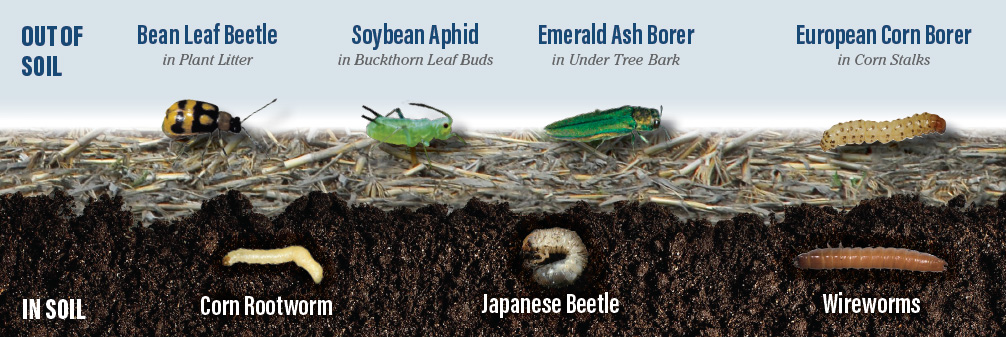Unspoken Truths About Pests: Winter Weather Impact

It seems logical … winter temperatures take a stark nosedive and several rounds of snow follow. Come spring, the pests that were spending their winter vacations in your fields should all be dead, right? The short answer: Maybe, but probably not.
“Cold winters help prevent many potential pest insects from establishing in the Corn Belt, particularly the upper Midwest,” says Anthony Hanson, University of Minnesota Extension specialist. “Additionally, extreme cold can knock back established species that are overwintering.”
BRUTAL TEMPERATURES
The cold typically needs to be extreme and prolonged to really impact pest mortality.
“Many insects can survive temperatures well-below freezing due to their own antifreeze compounds such as glycerol,” Hanson says. “For the most part, insects match the temperature of their surrounding environment, making them cold-blooded. Unlike warm-blooded animals, wind chill doesn’t really affect insects, but air temperature does.”
For pests that overwinter underground, soil temperatures are key for survival. For example, western corn rootworm beetles lay their eggs from late July through September.
Most eggs are laid within the top 4" of soil, although depths up to 12" have been reported. Above the soil, cornstalks, cover crops or leaf litter can add a layer of insulation, Hanson says.
Then, if the field receives a consistent blanket of snow, soil temperatures, especially lower in the profile, can remain moderate.
“Corn rootworm eggs begin to have some mortality near 20ºF,” Hanson says, “but that’s not full mortality.”
Based on laboratory studies, he says, corn rootworms eggs do
not near 100% mortality until soil temperatures are near 0ºF.
For the pests that overwinter above ground, winter mortality rates can be easier to predict with air temperature, but insect movement can make predicting next year’s risk difficult.
For example, soybean aphid eggs freeze between -25ºF to -35ºF, but even if winter lows reach -35ºF, summer adults are very mobile and can colonize new areas by field-to-field flight or long-distance travel on air currents, Hanson says.
As a result, wintering populations can recolonize in more northern areas from large parts of the Uppr Midwest where winter temperatures were not as lethal to the aphids.
PEST OUTLOOK
Winter is far from over, and many Midwestern regions saw a warm start.
“December was incredibly warm in a good portion of the Midwest,” says Dennis Todey, director of USDA’s Midwest Climate Hub. “A large chunk of the Midwest was well above average, 6°F to 12°F above normal.”
If the winter weather pattern stays warm, be ready for potentially higher pest issues this crop year, Todey says.
“Even if it is cold enough for pests not to overwinter, warm winters may mean they don’t have to go as far south to overwinter,” he says. “So, crop pests can be reintroduced earlier in the spring.”
Remember, pests can quickly multiply, Hanson says: “So even a small percent of the surviving population can still cause problems under the right conditions.”
When in doubt, scout early.
“Keep an eye on your fields,” Hanson says. “Know the general timing of when pests show up or even determine if this year pests could arrive earlier based on degree-days. Even when winter helps us out, you won’t know for sure if your field has pest issues or not until you scout.”
Where Pests Overwinter
Beyond weather conditions, where insects overwinter affects mortality, says Anthony Hanson, University of Minnesota Extension specialist. Here are where common pests typically spend the cold months.

Read more from this series, which shares insights on how to control pest problems.







